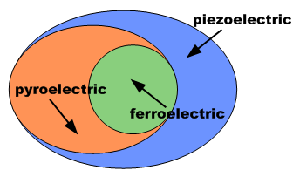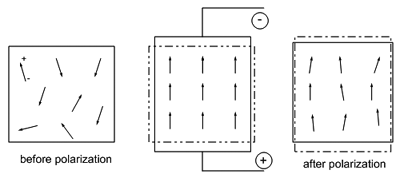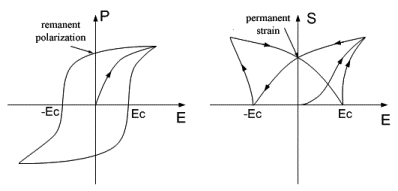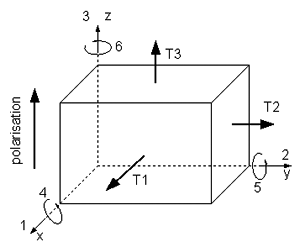The world of Piezoelectricity
This page is dedicated to piezoelectric materials. Many articles and websites discuss about the principle of piezoelectric effect and many links are available from this page. But, the main contribution here is about numerical and analytical modellings of this kind of devices. From the constitutive relations of piezoelectricity, we develop the approach to obtain the characterisics of elements in quasistatic or dynamic behaviors.
Summary
- Piezoelectric effect - Introduction
- Piezoelectric, Pyroelectric and Ferroelectric effects: What differences?
- History of the discover
- Applications
- Equations of piezoelectricity
- Different coupling modes
- What's append in the Viscoelastic energy conversion?
- The analytical quasi-static Modelling
- The analytical Resonant Modelling
- The Numerical modelling
Piezoelectric effect - Introduction
The piezoelectric phenomenon is the ability of some crystals to provide electric charges when they are compressed mechanically. The etymology of this word describes this property (from greek, piezo [-pièse, -piésie, -pisie], means compress). Reciprocal phenomenon also exists which is qualified of inverse effect: apply a voltage supply to the crystals provides a strain. Among the 32 categories of existing crystals, 20 present the piezoelectric property.
Piezoelectric, Pyroelectric and Ferroelectric effects: What differences?Among the piezoelectric materials, a first sub-category encircles the pyroelectric materials, and inside it a second category groups the ferroelectric materials illustrated below:

- pyroelectric materials:
The pyroelectricity is the ability of certain materials to generate an electrical potential when they are heated or cooled. The electric potentiel is developed in the same direction for a crystal. However, a modification of this direction can be observed with some of crystals by applying an electric field. This property is defined as the ferro-electric effect. - ferro-electric materials:
A ferroelectric material possesses a permament polarisation even if no external electric field is applied. Precisely, all elementary dipoles inside the material are oriented in the same direction.


Abbé Just-Hauy
(1743-1822) French mineralogist, was one of pioneers of mineralogy and modern christallography. He was the first observer of pyroelectricity property, which qualifies some natural crystals (quartz, sel de Seignette).Read more...
Pierre and Jacques Curie
(1859-1906)-(1856-1941) French physicists and brothers. They demonstrated the direct piezoelectric effect and quickly proved the reverse effect in 1881 based on the data collected by Lippmann.Read more...
Gabriel Lippmann
(1845-1921) French physicist, Nobel in 1908. In 1890' years, he was master of Pierre Curie and Maria Sklodowska (soon Marie Curie). Its reflections and tests about crytals permitted to emphasize the relation between geometry variations and electrization. Author of « Principe de la conservation d'électricité » in 1881, his work was essential for the validation by Curies brothers. Read more...Woldemar Voigt
(1850-1919) German physicist. He Improved the description of piezoelectric effect with Gottlieb Hankel. He published «Lehrbuch der Kristallphysik» in 1910, where he detailed the twenty classes of piezoelectric crystals, and defined precisely the piezoelectric coefficients by a tensorial analysis. Read more...Paul Langevin
(1872-1946) French physicist, was the inventor of the first piezoelectric application during the first world war with the engineer Constantin Chilowski, the Sonar. It was composed of thin quartz plates glued on iron plates and a hydrophone. Measurement of past time between emission and reception allows the estimation of distance with an object.Read more...
Piezoelectric properties are presently used in many fields of applications: automotive, robotic, medecine, aeronautic, home automation, embedded military systems...
Their purposes can be itemized according to the effect mainly exploited (direct, inverse or double effects) forming the sensors, actuators and transformers.
Under construction
ActuatorsUnder construction
TransformersUnder construction
OthersUnder construction
Equations of piezoelectricity


Under construction
What's append in the Viscoelastic energy conversion?Under construction
The analytical quasi-static ModellingUnder construction
The analytical Resonant ModellingUnder construction
The Numerical modellingUnder construction
The STATIC analysisUnder construction
The MODAL analysisUnder construction
The HARMONIC analysisUnder construction
